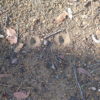Today, we had an interview with Ben, aged 10, a school boy in New South Wales who is doing a project on rain forests and the need for conservation. Ben sent me his questions by email and we hooked up with Skype, so he could record the interview.
I would like to share his questions and my answers with you – along with some of the photographs I sent to him by email for his project. The questions were all set by Ben and I simply answered them as I saw fit. His mother was present during the interview and was very pleased with the information Ben received.
1) How can we best preserve our rainforests?
It is very important that we understand the depth of their bio-diversity and that habitat is not just trees. Many people overlook little things about habitat: it is the fallen leaf litter and the decaying logs in which the lizards and the beetles live, as much as the beautiful butterflies in the tree tops.
I have been to Cairns in Northern Queensland and to Sabah in Borneo, to visit rainforests and to try and understand how we can ignore their value as part of our environmental health.
Rainforests need to be preserved in large areas, not little pockets here and there because our wildlife needs a lot of space in which to live.
2) You do something pretty special to preserve forests in Western Australia – what is that?
I am a blogger – because I believe the pen is mightier than the sword. If we want people to understand why we need to save forests and the unique creatures that live there, we have to tell people about them. We need words that describe how they live, why they are important and what is happening when we cut our trees down.

I was so lucky – I saw a Numbat in the forest the first night I was there and when I got to the camp, I heard that another had been seen just up the track, on Parrish Road. We were right in the middle of a Numbat colony – that is being logged! It is terrible to think about.
3) When did you start protesting, and why?
I have been a protestor for the environment for many years. I started getting more vocal about four years ago when I started blogging and protesting about the dolphin slaughter at Taiji in Japan. I began writing stories about the environment as long ago as 1994 and putting them on the internet. I have written about whaling and had a story about whales published on the ABC Environment website.
4) How does protesting help preserve forests?
It helps preserves forests in several ways:
It makes people sit up and take notice of what is happening which would otherwise not be reported
- It helps to actually stop the logging by us physically being there – in the same way as Sea Shepherd being in the Antarctic helps stop the taking of whales
- It adds to people’s education about what lives in the forests. Lots of people didn’t even know the Numbat is the official animal emblem of Western Australia until these protests started
By highlighting bad forest practices, we can get better management of our natural resources
5) Another way that you’re helping our forests is by writing children’s stories about them. Can you tell me more about that?
My stories are written under the name of “Stories My Nana Tells” and I can write a story about almost anything. I write for the 7 – 12yo market and all my stories are written so the children who read them find them interesting and help them learn something new. One of my favourite stories is “Where Have All My Spiders Gone?” and it combines a personal experience I had with a very clever spider and the idea that disturbing our natural environment upsets the food chain – causing species to disappear or become highly endangered. I wrote that story in 1994!
My goal is to get younger children thinking about how the environment is all interlinked – everything relies on everything else. Sometimes, life is a bit harsh. I saw three really beautiful orb weaver spiders get eaten right out of the middle of their webs a week or so ago – but, the bird that ate them had her own babies to feed. On the other hand, one of my friends sent me a picture of her orb weaver’s babies that had just hatched. Hundreds of them. So, there will be more next year.

6) What can kids do to help keep our Australian forests?
- Let their parents know they are concerned about having our forest preserved
- Get their schools engaged in projects about forests and having them declared as “hands off” areas
- Learning about the bio-diversity of their own local areas, who and what lives there and how that wildlife interacts with one another. Who lives there all the time; who migrates in from time to time?
- Writing to local and federal politicians, with their parents’ consent when there has been something in the news – because politicians are very sensitive about getting letters!
- Helping raise funds for local preservation and conservation programmes – which helps spread the word about the forests and our animals.
7) If someone wants to read your stories about the animals in the forest, how can they do that?
- They can join our community of parents and children – and read some of our free stories.
About Snippets….
If you like our Snippets, join us online, get your first premium story FREE and get regular updates of new postings.
Get started here, today.
(c) Lesley Dewar July 2012 to current.







Hi,
I remember seeing you at Warrup. If I’m right you are the one who got temporally lost. I love the work that you are doing. It is indeed a great way to help spread the message. I posted the following message on the Forest Rescue facebook page today. Perhaps we can collaborate in some creative way.
In campaigning to stop logging in native forests, although it is important to draw public attention to the fact that black cockys, numbats and others are endangered and may be brought to the brink of extinction by ongoing destruction of habitat, it is equally important to emphasise the roles such creatures play in the whole ecosystems to which they belong. Whilst we may have a holistic understanding of the integrity of ecosystems, it is is crucial to recognise that probably the vast majority of those who we seek to influence do not. Many people whilst viewing the loss of any particular species as regrettable, have no concept that this loss is inevitably accompanied by a corresponding degradation of the whole forest ecosystem. Nor of course does it have to be a 100% loss of particular species. Severe decline in numbers will result in whatever functions that creature performs in the system no longer happening in localised areas and will also result in a domino effect that will flow on to the relationships it has with other creatures. I am deplorably ignorant of how our forest ecosystems work but one example springs to mind. The black cockys chew the stems of gum nuts at a particular time in their maturity, presumably when the seed has set, thereby releasing them onto the ground. Were there no cockys to do this job, I suspect very few gum nuts would reach the ground in sufficient numbers to guarantee subsequent germination. Please feel free to provide examples of what I’m talking about. With a few concrete examples I may be able to create a song with a catchy tune that would get the idea across in a manner that would lodge in people’s minds. We need more than just banners and slogans; we also need to provide an understanding of what an ecosystem is across to the general public in a simple easily digestible way. This would strengthen our position considerably. The minister for the environment probably has a good understanding of politics but a poor understanding of ecology. With skilful guidance this could however be improved. I would like to see the words ‘endangered’ and ‘ecosystems’ linked. i.e. a banner could read ‘ More Logging = Endangered Ecosystem. This point could/should be emphasised in conversations with the minister, on air interviews etc.
Cheers,
Chris
Thanks Chris and, yes, I am the one who got lost for a short time while we were exploring the forest. I totally agree with you about the need to highlight and indeed educate people about the overall diversity of forest life. This is a topic I address in various stories I write and photographs I share. Sid: The Silver Skink is an important part of any story and photos about the camp at Warrup, as are the termites which feed the echidna and numbats. In telling the story, first of the black cockatoos and the numbats, we get to engage our audience. Then, we can address the very important story of bio-diversity and interdependence of species. I am delighted you have taken the time to comment on the story.
This unique article, “Interview With Ben (age 10) About Saving Forests”
was in fact great. I’m making out a replica to clearly show my close friends.
Thanks for your time-Olive
Olive – thank you for your lovely comment. We are really glad you like out interview with Ben. He and his Mum liked it too.